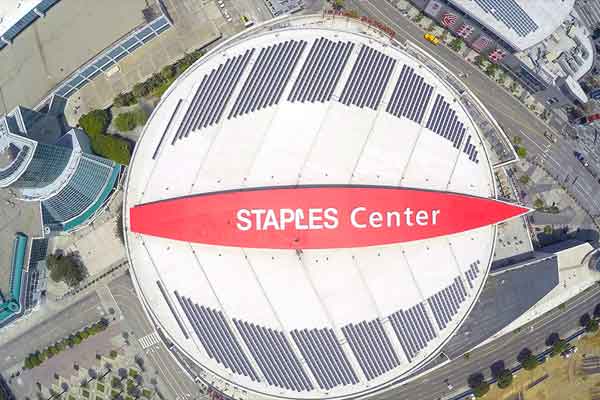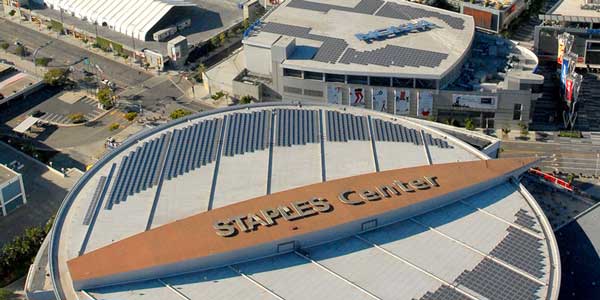Athletic organizations now realize how climate change and global warming may negatively impact games and sporting events around the world.
From the winter games to the Olympics, shortened seasons due to extreme weather may cause the suspension or canceling of gaming events, leading to loss of billions of dollars.
It’s no surprise that today most of these international organizations now look to sustainable technology and renewable energy generation in part to save money but also and most importantly, to combat a warming climate.
The Staples Center, home of both the National Hockey League’s Los Angeles Kings and the National Basketball Associations Los Angeles Clippers and Lakers, installed a 364 kW rooftop solar plant back in 2008.
This solar installation will cut carbon emissions by 10,000 tons.

Top View 
Side View 
Solar panels atop the Staples Center in Los Angeles
In 2012, the New England Patriots switched to solar power by installing nearly 2,600 rooftop panels on the Gillette Stadium in Foxboro, Mass.
The installation covers
In early 2018, the San Diego Padres installed the largest solar plant, for any Major League Baseball team.
The USD $1 million, 336.52 kW project, installed on Petco Park’s canopy is expected to supply a total of 12-million kWh of electricity over the next quarter century.
By adding solar, the San Diego Padres, will not only be reducing air pollution, carbon emissions but also saving on their utility bills by USD $4.11 million over the next 25 years.
Soccer clubs have also been stepping up their sustainability commitments with solar power, to keep up with their hockey, basketball and baseball counterparts.
After signing LeBron James earlier this summer, the Los Angeles Lakers UCLA Health Training Center is now home to 456 solar panels that are set to produce an estimated 245,000 kWh per year.
The basketball team could save around $38,000 annually by turning to solar power.
“We are thrilled with the addition of our new panels,” Joseph McCormack, chief financial officer and senior vice president of finance at the Lakers, said in a statement. “One of our goals as an organization is to be at the forefront of energy efficiency, and these panels further our commitment to sustainability.”
Major League Soccer’s (MLS) DC United will install an 884 kW solar array at its new stadium, Audi Field which is expected to open later this year.
The new solar power will provide 1 million kilowatt hours yearly and offset one-third of the stadium’s annual electricity use.
D.C. United closed on a $25 million clean energy funding package through the District government’s Property Assessed Clean Energy program, or PACE. The PACE funding included the financing of energy and water efficiency measures and an 884-kilowatt solar array installation in 2018.
The solar panels, in addition to other green initiatives, are expected to offset the stadium’s electrical usage by one third, saving D.C. United $125,000 a year on its utility bills.
“The solar energy and green features of Audi Field prove what’s smart for the environment can be good for local business, too,” said Bracken Hendricks Urban Ingenuity CEO, and Program Administrator for DC PACE (Property Assessed Clean Energy), on why going solar makes sense for the MLS club.
Improved markets and the declining costs of solar have made it more attractive for professional sports facilities.
According to the U.S. Green Building Council, there are currently 30 LEED-certified venues similar to Audi Field that are in use or are being built.
They include Nationals Park, certified LEED Silver, and American Airlines Arena, home of the Miami Heat.













Comments